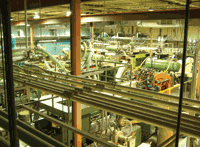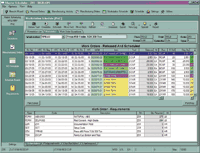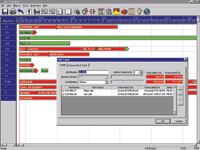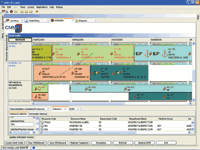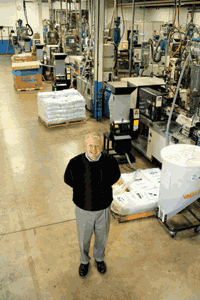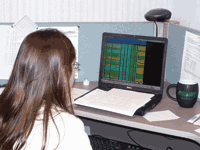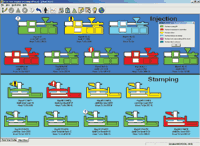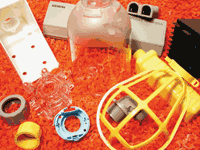State of the Tech: Is necessity the mother of ERP?
An IQMS customer since 2003, PanoCap replaced a partial homemade system plus a combination of two third-party systems for manufacturing and accounting.
November 1, 2006
|
When all of the beans are counted, molders who move from spreadsheets to ERP come out ahead. Some say way ahead.
Imagine the first factory that took the leap from paper-only production logs to computerized versions with a paper backup. Still a bit clumsy by today’s standards, the technology opened a whole new world for the managers and administrative staff.
Collecting and sharing data electronically has since evolved, but that same gee-whiz experience happens when molders move accounting and scheduling functions from spreadsheets to an ERP system. Time and time again, early adopters report how their eyes were opened to new possibilities once they took the plunge. Just how significant is this technology? In some circles (automotive, for one), it has become an essential part of doing business. To uncover the current state of this technology, IMM spoke with several software providers and ERP customers. They tend to believe that without the automated systems, it would be impossible to keep up with compliance and traceability issues. Just as important, though, are the benefits of keeping labor costs low, improving customer service, and being able to grow without growing pains.
IMM: What features of an ERP system are now considered cutting edge? Or, put another way, what are the features molders are looking for?
Randy Flamm, president, IQMS (Paso Robles, CA): ERP certainly handles all the financials and inventory, scheduling, and so on. That’s becoming almost a commodity. Everyone in the business has to have these functions. What we’re seeing is that customers want to extend this to include EDI [electronic data interchange]. Especially for automotive and appliance molders, all orders are coming over the Internet and they need to process orders hands off. We have customers with thousands of line items and it is prohibitive to enter these manually.
Another area of functionality for ERP systems is quality, both statistical and APQP [advanced product quality planning]. Customers want to be able to incorporate information about how the part is designed, PPAP [production part approval process] results, and other quality parameters. Warehouse management is another hot ticket, encompassing inventory control, bar codes, and shipping. All automotive OEMs and Tier Ones now require bar code labels on all parts, and in many cases when a truck leaves the building on its way to the OEM, molders must send an advance shipping notice with every serial number of every part on the truck. They’re using bar code and RF scanners, and would like to send that information back to the ERP system.
Glenn Nowak, VP sales, IQMS: Customers are trying to save both time and labor costs by reducing how often employees touch the system. They want the system to send them alerts—here’s what you need to order, here’s what shipments aren’t going out, and other “management by exception” parameters.
These and other requests are moving ERP systems out of the commodity range of just accounting and inventory. The system must be extended, and customers want it on a single database from a single supplier, without the need for a large IT staff to interface one system to another. They are trying to eliminate nonvalue-added costs. So ERP systems today must either incorporate all of these functions or be able to interface with all of them.
Users also want to be able to add functionality piece by piece, because requirements depend on the end user a plastics processor is supplying. Medical OEM requirements, for example, differ from automotive, so molders want different versions of certain modules that are split according to market requirements.
Perry Williams, general manager, DTR Plastics/Made2Manage Systems (Indianapolis, IN): Our new customers tend to purchase based on features and functionality, but after a few years, they are more concerned with ease of use and good customer support. We find the cutting edge is less about the product itself, and more about how the learning curve is shortened. We’ve surveyed potential customers, and people rank this in the top four of what’s important to them about an ERP system.
As far as technology specifically, we’re seeing more consideration of a move toward service-oriented architecture, where the user interface, business objects, and database are separated for ease of use and portability across all applications. It’s important to the future of our products and our customers, yet it is not one of the highest things on customers’ lists. It is a technical development that, from our perspective, will enable us to deploy new products rapidly with the same level of quality assurance customers expect. From a customer perspective, a service-oriented architecture translates to a number of tangible benefits, including executive dashboards, role-based user interfaces, automated workflows, supply chain integration, and product integration.
Curt Norby, Shotscope/Celltrack product line manager, Moldflow (Framingham, MA): We have two products that interface with ERP systems—Celltrack is primarily production monitoring and management while Shotscope captures both production and process information, such as pressures, temperatures, and positions of the cycle itself. Our customers want enterprise tools that allow them to look at aggregate data across the network and also the individual cycles of each machine, especially in the more technically demanding markets. Automotive and medical OEMs are looking for the fine details of what it took to make the part, for example.
We find that a large percentage of customers have interfacing with an ERP system as a main requirement for both products. Information must be shared in both directions. Our systems have to pass data to ERP systems but there is also a need for ERP systems to deliver a schedule to our system. So production and process monitoring programs need to have a bidirectional interface to eliminate dual data entry.
What we also see is that captive molders are going to larger enterprise solutions such as Oracle and SAP, which tend to be heavily resource-oriented. Custom molders are much more interested in plastics-specific programs that are tailored to their operations.
Mick Thiel, president, Mattec (Loveland, OH): A major change that I’ve seen over the past few years is that customers want to control the “big three”: materials, labor, and machinery. Labor is being controlled by downsizing. Materials and machinery costs are still high. To get the most out of materials and machinery in terms of efficiency and productivity, molders and all manufacturers need information. They say, “Get me the information on the machinery so that I can take corrective actions now to improve productivity.” ERP systems today control materials traceability as well as serialization of products and components. This is a capability they didn’t have a few years ago. Information is provided by bar code or RFID readers, both on the shop floor as well as in the shipping department.
IMM: What’s being done to foster integration with production and process monitoring systems?
Brian Angle, VP sales, CMS Software (Richmond Hill, ON): In most systems, scheduling is done on a weekly or daily basis. Now, to take full advantage of integration, ERP systems are turning to what we call dynamic rescheduling. The ERP system gets real-time information on actual machinery. If a job is running over, the integration enables a production monitoring system to reschedule follow-on jobs, and then feed this back to the ERP system on a real-time basis so a customer service rep can be notified to call the customer. It comes down to customer service, and is a big advantage that North American molders have over offshore competitors.
Medical and food packaging are the biggest growing markets in North America, and both are looking for a higher degree of traceability. One feature in the CMS system enables real-time capture by lot number and container number for raw material, work in process, and finished goods. We know what material is being consumed in the making of each part. Coupled with the need to keep costs low, the solution is technology that integrates right out of the box with low staff levels and no consultants.
Flamm (IQMS): With the integration of ERP and production monitoring systems, data flow is sent as a signal from the machine for every cycle, so that the ERP system knows what’s running in each machine. From there, we know what raw materials to pull from inventory to replace what was just used, and where that just-made part is going. We also get a signal if the part is scrapped. From an accounting standpoint we need to know if you make a part, is the part good? The majority of progressive molders out there have equipment with process monitoring built in—they can tell us if the part is good or bad—just as they tell the robot to segregate a part if it’s good or bad. Our ERP system receives this signal from the machine to enable greater control.
Williams (DTR): We have worked with a number of partners over the years, and continue to actively pursue integration with them. One of our tightest integrations is with Syscon PlantStar, which has improved responsiveness and robustness of our overall solution. We offer single-source support for all of our integrations, so that no matter what issues our customers have, we can solve them.
Thiel (Mattec): Customers want total integration that relates runtime, downtime, and process capabilities—temperature, pressure, speed—to quality, and they want that integrated into the ERP system in an automatic and real-time manner. No one has taken it to this extent yet, but this is where the industry is heading.
The industry is also demanding one-time, or automatic, reporting. Molders don’t want different systems or unconnected islands of automation, but rather, the same information flowing to and from the shop floor, shipping, sales, and purchasing. Entering data twice into two systems is counterproductive. If one person says a machine is down, then the ERP system, customer, operator, and management should know it’s down. It requires master data across the whole plant, which is similar to controlling multiple plants from a single location. The enterprise can be tied together by high-speed networks that allow the head office to see data in real time, at the time a part is made or bar coded.
IMM: At what size do you recommend molders switch from spreadsheet financials to ERP?
Flamm (IQMS): At about 10 IM machines or more, every time you add another press, you have to add indirect labor, inventory control, and more administration. Or, you can continue to grow without having to add more indirect labor so that the profit goes to the bottom line by incorporating ERP. Molders can start out small and grow into a system. Smaller molders, too, can add capabilities that large molders can’t handle because they have a monolithic system. For automotive, medical, and appliance customers, the compliance issues are almost insurmountable without ERP and automation for labeling, lot tracking, and certificate of conformance—which includes every lot number of resin used in a shipment. Having lot number traceability is huge for the user. The recall of a part due to bad resin can be limited to only one lot number rather than every lot produced.
Nowak (IQMS): Molders often start small, but the goal is to grow. It’s a big mistake to manage by spreadsheet. We’ve installed systems for as few as three users, who can then add seats, modules, and machines one at a time. Angle (CMS): When do you switch from the Excel spreadsheet? At $15 million to $20 million in yearly sales you almost can’t afford not to implement ERP and shop floor monitoring. One of our customers sent parts to a Tier One automotive supplier, who told him the parts were giving them problems on the assembly line. He was able to document all of the production data and prove that his parts weren’t at fault. With downtime penalties on the assembly line as high as $5000/min, this can be a lifesaver.
We’re living in an era of compliance. Suppliers have to be able to meet these issues. Being small is not an excuse. You have to have traceability, bar code labeling, EDI. You can either buy an integrated system or hire additional staff. We’ve replaced systems designed for more staff than is needed. Buying an integrated system allows you to do more with less.
Thiel (Mattec): We can go into a small company and put in a basic monitoring and scheduling system for $25,000. But at 25 or more machines, integration with shop floor control and ERP is essential to eliminate double data entry. A number of companies want to stay on the threshold of technology. Others don’t want to be left behind because their competitors are using it. At enterprise levels, the total cost of ownership is roughly $100,000 for software, implementation, and the learning curve. Amortized over its lifespan, it’s a trivial cost for the benefits provided.
Analyzing returns |
Integrate and graduate |
Contact information |
About the Author(s)
You May Also Like
